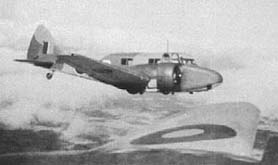

Ramsbury Airfield
My
Interest | Aviation
Archaeology | Ramsbury's
Home Front
| 101st
Airborne Division |
Obituaries
| Savernake
Ammo Dump | 101st
Artillery | The
Great War
Mystery Corner
| Membury
Airfield | Normandy
- some places of interest
| Home
Page |
Links Page
| Recommended
Reading
| Aldbourne
Stable Project
Ramsbury Airfield - A Brief History
The area chosen by the Air Ministry for Ramsbury airfield lies about half a mile south of the village, ideally situated high upon the hill which dominates this part of the Kennet valley.
Construction began in mid-1941 and the majority of the work was completed by August 1942. Initially the plan was for the airfield to be used by Operational Training units from RAF Bomber Command, but following America's entry into the war it was earmarked for use by the United States Army Air Force (USAAF) for troop carrying operations. (See also Membury airfield).
However before the Americans arrived the aerodrome was occupied by an RAF training unit, equipped with Airspeed Oxfords, who taught the pilots the rudimentary skills needed to control multi-engined aircraft. The unit was Number 15 (Pilot) Advanced Flying Unit (15 [P] AFU) and whilst at Ramsbury large numbers of British, Australian, Canadian, New Zealand and South African pilots passed through the school. Ramsbury also had its own Women's Auxiliary Air Force (WAAF) contingent, who were employed as parachute packers, cooks, drivers, storekeepers and administrators.


Above left: R5946 pictured whilst flying on exercise from Ramsbury (E. Berry). Above right: A surviving Airspeed Oxford photographed at the Imperial War Museum at Duxford, Cambridgeshire.
After the pilots had successfully passed their course with No 15 (P) AFU at Ramsbury they were moved on to an operational training unit (OTU).
Below left: 'Bill' Berry (RAAF), 2nd right, a former pupil at Ramsbury stands with his crew beside Wellington BK181 at No 29 OTU RAF Bruntingthorpe (E. Berry). Below right: Flight Lieutenant Ernest 'Bill' Berry DFC (E. Berry).
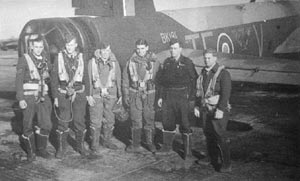
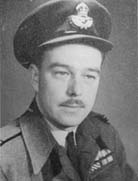
Once the OTU course had been completed the airmen were sent to an operational squadron. 'Bill' Berry and his crew were assigned to No 50 Squadron flying Lancasters at RAF Skellingthorpe.
Below left: This Lancaster Mk III ED585 'G' George was flown by Bill on 25 occasions. The aircraft went on to record 128 missions before being lost on a raid over Konigsberg on 29/30th August 1944 (E. Berry). Below right: 'Q' Queenie from 50 Squadron pictured just before she was lost (E. Berry).
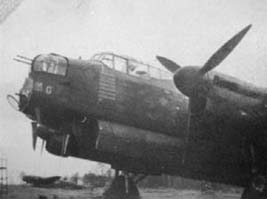
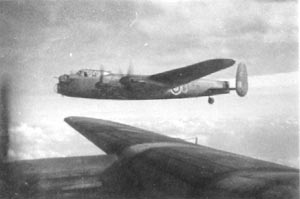
The 437th Troop Carrier Group Arrive
By the end of 1943 both 15 (P) AFU and the WAAFs had departed and it wasn't long before the Americans moved in. In February 1944 aircraft from the 437th TCG began to arrive. The unit was a part of the US Ninth Air Force and whilst at Ramsbury spent time training with the 101st Airborne Division in preparation for D-Day.

Many of the personnel regularly patronised the village shops and pubs in the valley below. A short truck ride to Hungerford railway station meant they could catch a train to London, and whilst there many visited the American Red Cross club at Rainbow Corner. Here the homesick yank could 'shoot pool', play Jukeboxes and have his hair cut in a 'home town' barber shop. Many of the American Servicemen also enjoyed visiting dance halls and cinemas in Swindon and Newbury.
Training started in March and the pilots practised towing gliders (the American Waco CG-4A and the British 'Horsa') and dropping parachutists from their C-47 aircraft, although not simultaneously! The training paid off and by June all the personnel were ready for D-Day ('Operation Overlord'). On 4th June 1944 the men were briefed about their mission and sworn to secrecy. They were not allowed to speak to anybody outside the airfield. Early on the morning on 6th June the planes and paratroops left for Normandy, many never to return. On 29th May 18 aircraft from the 85th Squadron were sent on detached to Membury where they joined the 436th TCG. To learn more about the 85th Squadron's stay at Membury click here.
Below: A fine study of 84th TCS C-47s taken by 2nd Lt. Erroll S. Gates from the cockpit of his aircraft (serial number 42-100974). The drawing of the plane that flies across the top of this screen (Z8 - N) is based on Lt. Gates aircraft. See profile below.
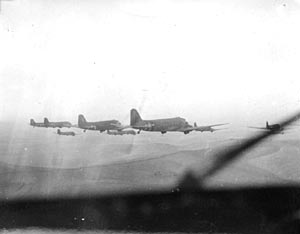
Below: Lt. Gates named his aircraft 'Jeanne Lee' after his wife. The profile below shows C-47 42-100974 as it would have appeared on the eve of D-Day (6th June 1944).
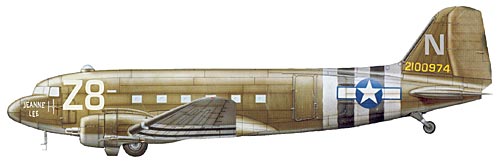

Above: Between 29th May and 6th June 1944 eighteen aircraft from the 85th TCS were temporarily assigned to the 436th TCG at Membury. This 85th TCS C-47 (42-100806) carried paratroopers from the 377th PFA to Normandy on D-Day and was number 82 of the ninety aircraft formation. The crew consisted of the following personnel: Pilot - 1st Lt. Floyd Kelly; Co-pilot - Capt. Joseph Antrim; Navigator - 2nd Lt. Joseph Salisbury; Crew Chief - T/Sgt George Montgomery and Radio Operator - S/Sgt Donald Bolce.
Below left: 84th Squadron Officers Club. Below centre: Led by 1st Lt. Keith Stuart several officers of the 84th Squadron made this ice man carving near their quarters. It represented their CO Cpt. John Campbell who was not best pleased by the result. However he felt a little better when Col. Hudgens saw the carving and said it was a good likeness. Below right: 2nd Lt. Erroll S. Gates and his crew beside aircraft serial number 42-100974. (All three pictures Erroll S. Gates).

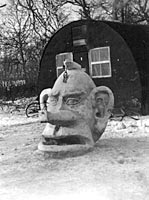
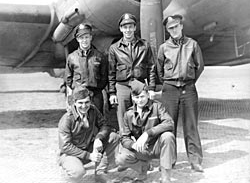
Below left: Sgt. Milton K. Priest, 84th TCS mechanic. Below centre: Sgt. Priest's Enlisted Man's Identification Card. Below right: We believe this picture shows Mr Russell Bear Jr. Can any reader confirm his identity? Also please see Mystery Corner (All three pictures via Michael C. Clary).
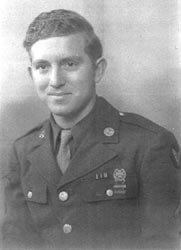
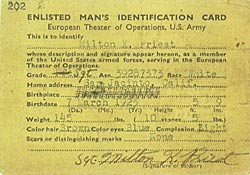
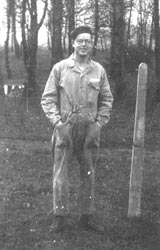
D-Day 6th June 1944
![]()
![]() Click
here to see photographs of the 437th's Normandy missions and subsequent resupply
sorties.
Click
here to see photographs of the 437th's Normandy missions and subsequent resupply
sorties. ![]()
![]()
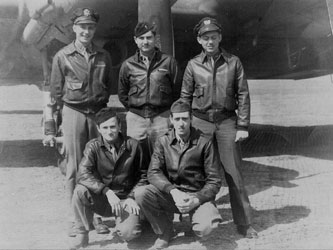
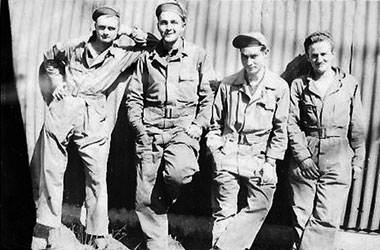
The above
photographs were sent to me by J. Paul Lefever son of T/Sgt Paul B. Lefeve who
was a crew chief with the 84th TCS. Above left: Back row left
to right;
Pilot - unknown; Co-pilot - 2nd Lt. Oscar B. Hill; Navigator - Elmer Schaer.
Front row; Crew Chief - T/Sgt Paul B. Lefever; Radio Operator - S/Sgt Earl Nordgren.
Above right: 84th TCS Crew Chiefs at Ramsbury. From left to right;
T/Sgt Herman Jenisch; unknown; T/ Sgt Robert Hendrickson and T/Sgt Paul B. Lefever.
CAN ANY READER IDENTIFY THE TWO UNKNOWN AIRMEN?
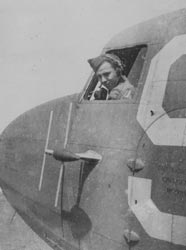
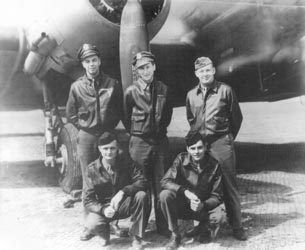
Above left: Radio operator Sgt. Ed Goldstein posing for the camera in the cockpit of an 85th Squadron C-47. The antenna below the window was one of a pair mounted on either side of the cockpit area. It was a part of the Rebecca/Eureka radar beacon and responder system that was used on D-Day to help guide troop carrier aircraft to their designated drop zone areas (P. Demos via D. Bolce). Above right: 1st Lt. Frederick Wurst (left standing) and his 84th Squadron D-Day crew. Clockwise from back centre; 2nd Lt. James Carter (Co-pilot), 2nd Lt. Richard Denison (Navigator), S/Sgt. Werner Beugger (Radio Operator) and T/Sgt Herman Jenisch (Crew Chief). In mid July 1944, because of a shortage of navigators in Ninth Air Force Bomber Command, Richard Denison was transferred to the 386th Bomb Group equipped with the Martin B-26 Marauder. He flew as a navigator with this group for the remainder of the war clocking up a total of 42 combat missions (R. Denison).
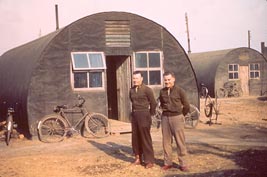
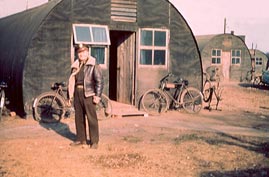
Above: Two very rare colour images. Left: 84th TCS Co-pilots 2nd Lieutenant's John C. Cole (left) and Donald W. Handegaard standing near their Nissen hut at Ramsbury in the Spring of 1944. Sadly, Lt. Handegaard was killed on D-Day when his C-47 (42-100803) crashed in Normandy during the squadron's first combat mission. Right: Lt. Richard H. Denison, 84th TCS Navigator, standing in front of the same building. About a dozen officers, normally a mixture of pilots, co-pilots, navigators and glider pilots, would share each hut. (Both pictures R. Denison)
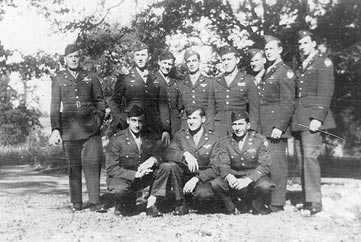
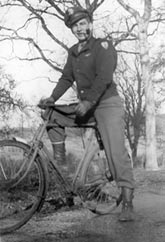
Above
left: During the summer of 1944 Kenneth Perkins, a pilot with the 86th
Squadron, took this picture of his room mates at Ramsbury. They are from left
to right:
Back row: Raymond Geheris; Wilmer Francis; Ira Pierce; Joe Alberti; John
Kelly; Pat Murphy; Bill Seeton; Paul Frudenburg.
Front row: Albert Norris; George Anthony; Julian Serra.(K.
Perkins)
Above right: Kenneth Perkins on his 'Ramsbury transportation'.
In order to travel easily around the vast expanse of the airfield and to explore
the
surrounding countryside, many GIs bought their own bicycles, some paying outrageous
'black market' prices for them! (K. Perkins)
Below left: Aircraft of the 437th TCG dropping parachutists, near Ramsbury (J. Reeder). Below centre: "Mail Call". The sign above the window reads: 86th T.C. Squadron Mail Room (F. Becker).Below right: Dick Pearson 'just fooling around' (R. Pearson).

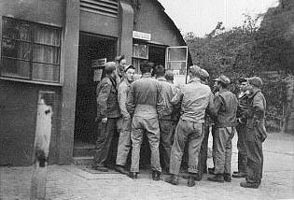
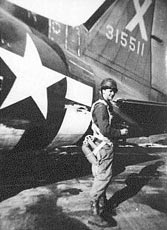
Below left: Davenport, Montgomery and Bolce beside their aircraft at Ramsbury. Below centre left: Radio operators living quarters affectionately called 'Ye Olde Static Attic'. Below centre right: 85th Squadron radio operators outside their Ramsbury Nissen hut. (All three pictures D. Bolce). Below right: Vic Affatigato, 85th TCS Radio Operator, near his Nissen hut in the 85th 'non coms' living area. (V. Affatigato)
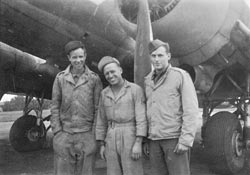
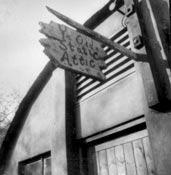
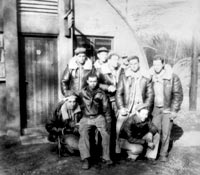
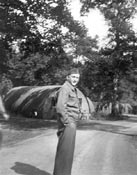
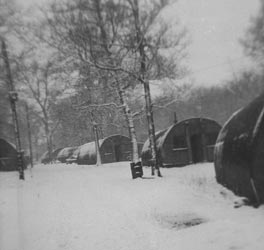
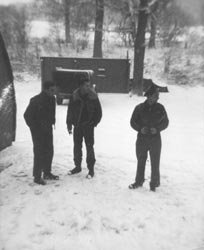
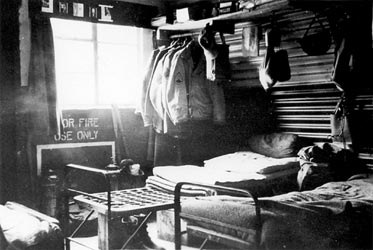
Above
left and centre: The 85th TCS enlisted men's area pictured during the
winter of 1944/45. Each Nissen hut was equipped with one solitary
pot
bellied coal burning stove that was of insufficient size to heat the structure
properly. The building in the background of the centre picture is a
latrine block. (Both pictures P. Demos via D. Bolce) Above right:
Inside a Nissen hut. (F. Becker)
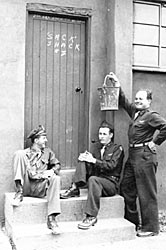
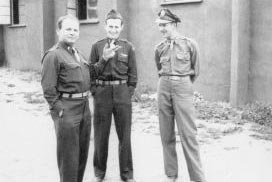
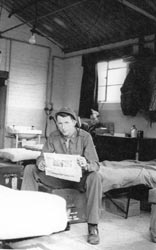
In
addition to the
Nissen hut design there were two other types of building used as living accommodation
at Ramsbury. Above left: This picture shows (from left to right)
Lt. Marcus Passwater, Lt. Ernie Duhaim and Lt. Erbeck (with bucket), in front
of their living quarters which they named 'Sack Shack II'. These buildings (also
used as offices and mess halls) were constructed of brick, covered with cement
and roofed with corrugated asbestos sheeting. Above centre: The
same group with their hut in the background. Above right: Marcus
Passwater sitting on his bed inside the hut studying a copy of 'Stars and Stripes'.
(All three pictures M. Passwater)
Below left: Manufactured by the British Concrete Federation and known
as BCF huts, these buildings were made from prefabricated sections of reinforced
concrete.
Only ten were built at Ramsbury. Below
right: Inside one of the BCF huts that served as living accommodation
for 84th TCS Pilots. (Both pictures E. Gates)
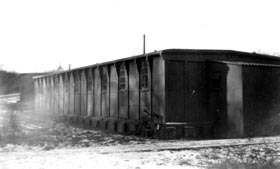
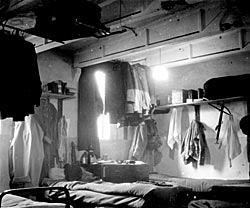
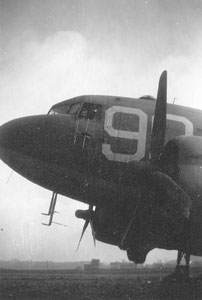
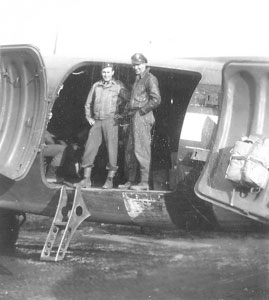
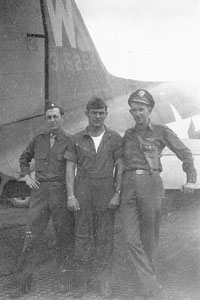
Above
left: Marcus Passwater's usual aircraft was 43-15252, which was named
'Little Ernie'. Above centre: Marcus (on right) is standing in
the rear cargo
door with his
pilot Ernie Duhaim. Above right: Marcus (on the right again) leaning
against the tail of 43-15252. (All three pictures via Steven Passwater)
Support Units
A number of smaller specialist units were attached to the 437th TCG during its time in the European Theatre of Operations (ETO). A short history of four of these units; 814th Air Evacuation Squadron; 69th Station Compliment Squadron; 337th Service Squadron and the 1455 Ordnance Medium Maintenance Company can be viewed by clicking this link. Specialist units.
The Invasion of Southern France
On 12th July the 437th were told they were leaving Ramsbury for Italy to take part in another combat mission. This new operation, code named 'Dragoon', was the invasion of southern France. Click here for more information and photographs.
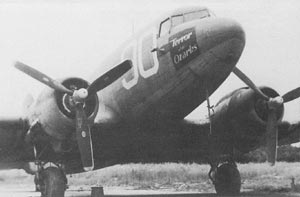
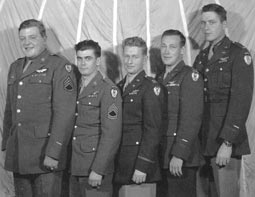
Above left: On 24th August 1944, during the group's return flight from Italy, aircraft 42-100636 'Terror of the Ozarks' piloted by 1st Lt. William 'Tommie' Thompson, ran short of fuel and was forced to ditch in the sea off the Cornish coast near Land's End. Its crew and passengers escaped without injury and were rescued by two British minesweepers (HMS Willow and HMS Sycamore). Above right: The crew of 'Terror of the Ozarks'. Left to right; S/Sgt. Isadore Schwartz; T/Sgt. Douglas Mitchel; 1st Lt. William Thompson; 2nd Lt. Benjamin Campbell and 1st Lt. Rollo Jacobs. (M. Passwater)
On 17th September 1944 the 437th TCG took part in 'Operation Market Garden' - the invasion of Holland.
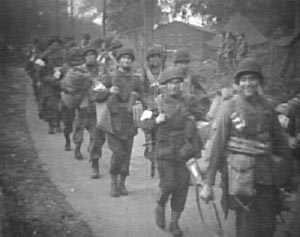
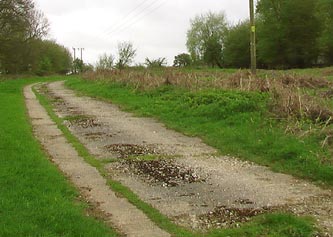
Above
left: Members of the 101st Signal Co. marching from their bivouac area
at Ramsbury to their waiting CG4A Gliders. This, and the six pictures below
are stills taken from a film shot by US Army cameraman Gerard on the morning
of 17th September. The second man from the right (in British uniform) is Corporal
Frederick Sellers of the Royal Corps of Signals. Sadly, Corporal Sellers was
killed later that day when his glider crashed near St Admans, Belgium. (US National
Archives)
Above right: The same concrete road in May 2005.
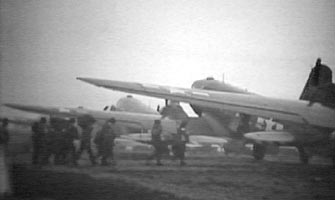
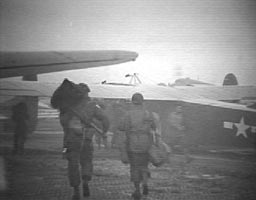
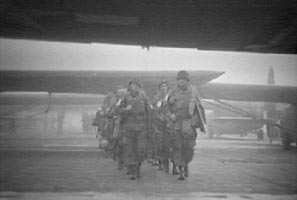
Above: 101st Airborne soldiers approaching their gliders. (US National Archives)
Below: C-47s and CG4A gliders lined up at the eastern end of runway 260 waiting to depart. (US National Archives)
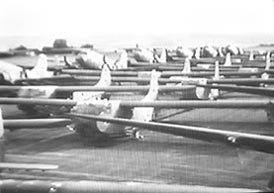
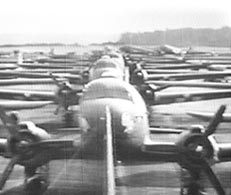
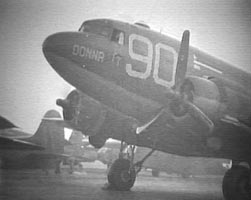
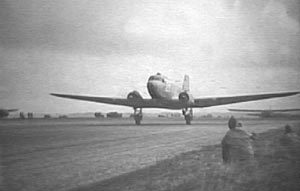
Above left: Eighty-fifth Troop Carrier Squadron aircraft 'Donna' starting its engines. Above right: A plane from the 84th TCS with CG4A glider in tow races down runway 260. (US National Archives)
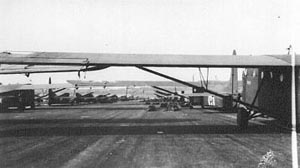
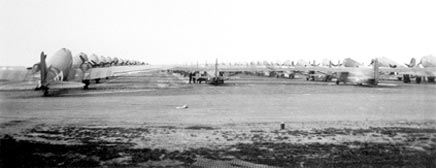
Above left: Waco CG-4A gliders on Ramsbury's main runway, 17th September 1944 Above right: Looking west from the end of runway 260 (Both Pictures D. Ferriolo).
Above: This picture was taken on Monday September 18th 1944 (D-Day+1) and shows LZ 'W', which was located about 5 miles north of Eindhoven and two miles east of Best. Four serials of between 35 and 40 C-47s from the 437th TCG all towing CG4A gliders, left Ramsbury for this landing zone on 17th and 18th September. The 437th lost seven powered aircraft and 18 crew members during the first day of operation 'Market Garden' and this proved to be the darkest day in the group's entire history.
The
original caption to the photograph reads as follows:
LZ "W" , DZ's "B" & "C" - D PLUS
1
DOTS EMPHASISE GLIDER POSITIONS. 368 GLIDERS ARE SEEN. 3 ARE CRACKED UP. 3- C-47s ARE SEEN IN CIRCLES. ALTHOUGH 485 CG4As WERE DISPATCHED ON D DAY AND D PLUS 1 THE OPERATION WAS STILL CONTINUING WHILE PICTURES WERE BEING TAKEN (NOTE 2 C-47s AT BOTTOM OF PICTURE JUST AFTER RELEASING GLIDERS) FURTHERMORE ADDITIONAL AREAS EAST AND SOUTHEAST ARE NOT INCLUDED IN THIS PHOTO COVERAGE. NUMBER (1) POINTS OUT GENERAL CONCENTRATIONS OF PARACHUTES WELL WITHIN DZ BOUNDARIES.
FROM EVIDENCE BASED ON THIS PHOTO THE AVERAGE DENSITY OF GLIDERS IS ONE GLIDER EVERY 120 YARDS BY 120 YARDS, OR 14,400 SQUARE YARDS.
(With grateful thanks to Mr Patrick Antrim, son of the late Joseph Antrim, for granting me permission to reproduce this picture, and to Tom Potter for bringing it to my attention).
After the mission was completed the group continued to supply troops on the continent with ammunition, petrol, medical supplies and food rations. During late December the 437th became involved in dropping supplies to the beleaguered 101st Airborne Division that was surrounded by German forces at Bastogne, Belgium. In February 1945 the 437th TCG left England and moved to France.
A58 Coulommiers, France and Operation 'Varsity'
On 25th February 1945 the 437th left Ramsbury, its home for just over a year, and moved to an airfield known to the Americans simply as A58, situated near the town of Coulommiers some 20 miles east of Paris. The following photograph was taken there by Don Bolce, a radio operator with the 85th Squadron, and show his aircraft 42-100806 at dispersal.
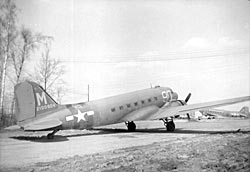
![]()
![]() Click
here to see more photographs of the 437th at Coulommiers
PLUS the story of the group's
participation in Operation 'Varsity'
Click
here to see more photographs of the 437th at Coulommiers
PLUS the story of the group's
participation in Operation 'Varsity'
![]()
![]()
On 5th June 1945, a month after the war in Europe had ended, USAAF Station 469 was returned to RAF control. Ramsbury continued to operate as an active airfield until the end of March 1946 when its status was downgraded to 'care and maintenance'. The airfield closed in 1947 and was never used again as a military base.
Ramsbury airfield today
Below
left: Ramsbury airfield from the air looking north-east,
summer 2001. (Mark Brock).
Below
right: Ramsbury airfield looking east. Littlecote Park is in the middle
distance, spring 2007. (John Akerman)
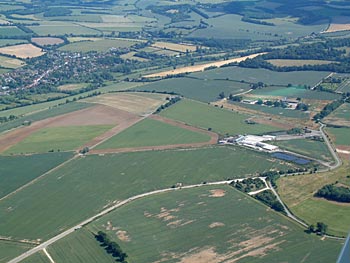
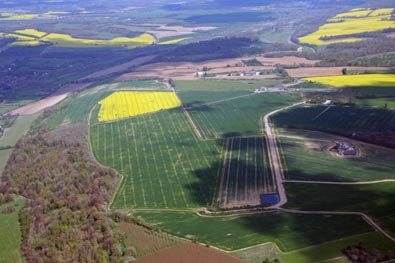
Below
left: New
Zealander, John Aitken (ex 15 (P) AFU) looking towards the site of his old billet.
Below right: Australian,
Bill Berry (ex 15 (P) AFU) standing on what remains of one of Ramsbury's runways.


Below
left: This splendid
image was produced for Vic Affatigato for a recent 437th TCG reunion and shows
a C-47 towing two CG4A gliders.
Below right: Veterans of the 437th TCG on the main runway at Ramsbury
during a reunion in November 1997.
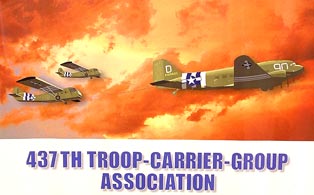

Below left: Ex 437th TCG glider pilot Jack Whipple at The Museum of Army Flying, Middle Wallop in November 1997. He is standing in front of an Airspeed Horsa glider, similar to the one he flew into Normandy on D-Day. Below right: Waco CG-4A (top) and Airspeed Horsa gliders.
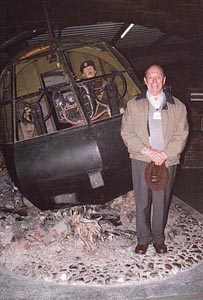
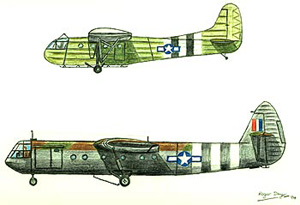
Below left: Exhaust flame damper found recently in woods near Ramsbury airfield. Below right: Similar damper as fitted to the C-47 in the Airborne Museum at Ste-Mere-Eglise.
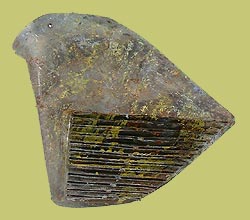
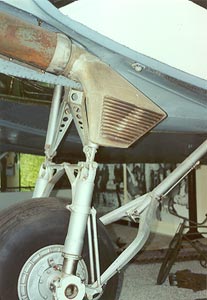
Although nearly 60 years have passed since the end of WW2 items of interest still come to light from time to time.
Below are a selection of items that have been found in woods, fields, sheds and gardens in the Ramsbury area.

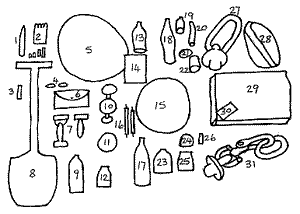
Key to above photograph:
1. .50 cal. Browning machine-gun round. 2. .3 cal US Garand 8 round clip. 3. .303 cal British round. 4. US Paratrooper jump wings. 5. US paratrooper steel helmet. 6. US Army issue sewing kit. 7. Equipment harness attachments. 8. US Army entrenching tool. 9. Shaving cream tube. 10. US Army issue compass. 11. Preserve jar lid. 12. Ink bottle. 13. After shave bottle. 14. US Army issue diary. 15. Cast iron airfield landing light cover. 16. Airfield lighting cable. 17. Sauce bottle. 18. Coke bottle dated 1941. 19. Medicine bottle. 20. .50 cal. Browning machine-gun round. 21 Sun glass lens. 22 Paste jar. 23 After shave bottle. 24. Crockery marked NAAFI 1942. 25. Medicine bottle. 26. .45 cal. M1911 US round. 27 and 31. Glider/tow aircraft tow rope connectors. 28. US mess-tin 29. .30 cal. US ammunition box. 30. Small strip of 35mm film.
Below left: Part of the main undercarriage from a Waco glider found on Ramsbury airfield in 1995. Below right: Close up of stub axle and wheel hub showing the brake cylinder which still retains its original rubber seals.

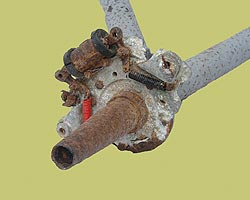
My
Interest | Aviation
Archaeology | Ramsbury's
Home Front
| 101st
Airborne Division |
Obituaries
| Savernake
Ammo Dump | 101st
Artillery | The
Great War
Mystery Corner
| Membury
Airfield | Normandy
- some places of interest
| Home
Page |
Links Page
| Recommended
Reading
| Aldbourne
Stable Project
© Copyright 2014 Roger Day